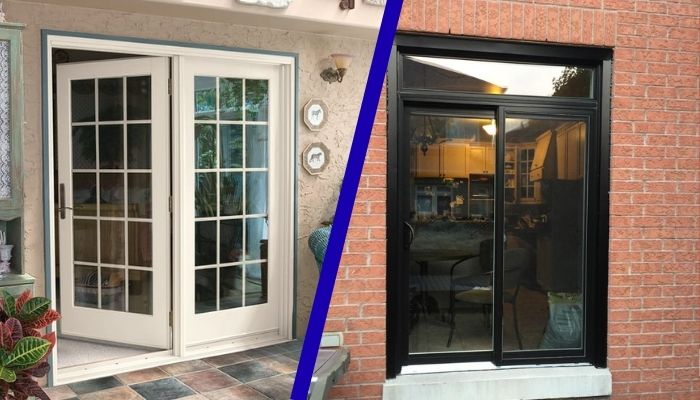Sliding vs French Patio Doors for Toronto: Which One Performs Better?

Your patio door isn’t just something you open and close. It’s the place where your home meets the outdoors, where sunlight comes in, and where you feel the difference between a drafty room and a cozy one. That’s why picking the right patio door style actually matters more than most people think.
Two of the most common choices today are sliding patio doors and French patio doors. They both look beautiful and work well . They're just made for different types of homes and different lifestyles.
In this guide, we’ll show you how each door works, how they perform in Toronto’s weather, and which one might be the better fit for your home.
What Is a Sliding & French Patio Door
Sliding Patio Door

A sliding patio door moves horizontally along a track. One panel stays fixed, and the other glides open. It gives you a wide glass area, a clean modern look, and smooth operation.
Sliding doors work especially well in tight spaces because they don’t need a swing room. They’re popular in condos, townhomes, and homes that want bigger outdoor views.
While simpler in appearance, sliding doors offer strong performance with a modern feel.
French Patio Door

A French patio door has two hinged panels that swing open either inward or outward. It’s a traditional, classic style that looks elegant and welcoming.
The frame is thicker, and the design feels more like a grand entrance. You can choose different swing directions depending on your space.
French doors add character and charm, especially in older or more traditional homes.
Sliding vs. French Patio Doors: Comparison From Different Sides

Durability and Weather Resistance
Sliding doors handle Toronto’s weather very well. They seal tightly, resist drafts, and stay stable during snow, rain, and wind. The interlocking panels add extra protection against air leakage.
French doors work well too, but they have more moving parts and more places for air to get in. The meeting point between the two doors can let in drafts if not sealed properly. In winter, the swing space can also get blocked by snow.
If you want something steady and dependable all year, sliding doors are usually the more weather-resistant choice.
Insulation and Energy Efficiency
Sliding doors with high-performance glass offer great insulation. The panels fit tightly, and the large glass area lets in natural light while keeping heat inside. This helps maintain indoor comfort through Toronto’s cold seasons.
French doors can insulate well too, especially premium models. But the gap between the two swinging doors can allow more air movement. Cold air can sneak in if the weatherstripping wears down.
If energy savings and stable indoor comfort matter most, sliding doors typically perform better.
Style and Appearance
Sliding doors are modern and minimal. They offer wide views, slim frames, and a clean design. They make a room feel more open and bright.
French doors have a classic, elegant look. They add charm and make your patio entrance feel like a special feature. You can choose between different panel styles and glass designs.
If you want something modern and bright, sliding is the way to go. If you want timeless beauty and a welcoming feel, French doors are a great choice.
Maintenance Requirements
Sliding doors are simple to maintain. You may need to clean the track, wipe the glass, and occasionally check the rollers. Other than that, they stay in good shape with very little effort.
French doors require a bit more attention. The hinges, seals, and meeting point between the doors may need occasional adjustments. If the door is wood or hybrid, you may also need to repaint or refinish it.
If you want a door that stays easy to care for with minimal work, sliding doors have the advantage.
Security and Structural Performance
Both types of patio doors can be secure. What matters most is the frame, lock system, and installation.
Sliding doors often come with multi-point locks and anti-lift features. The interlocking panels add extra strength.
French doors look solid, but the center joint where the two doors meet can be a weak spot if the hardware is not high-quality. With the right frame and locks, they can still be very secure.
For a tighter seal and stronger feel, sliding doors usually provide more consistent protection.
Cost Comparison
Sliding doors usually cost less than French doors. They’re simpler to build and easier to install, which helps keep the price lower.
French doors cost more because of their thicker frame, hinges, and swing mechanics. If you choose a premium style or decorative glass, the price goes up further.
If you’re on a budget or need a large glass opening, sliding doors offer better value. If you want a statement piece with a classic look, French doors may be worth the extra cost.
Feature Comparison Table
Feature | Sliding Door | French Door |
|---|---|---|
Durability | Excellent for Toronto climate | Good, but seals may need more care |
Insulation | Strong and consistent | Good, depends heavily on sealing |
Maintenance | Low | Moderate |
Aesthetics | Modern, bright, minimal | Classic, elegant, traditional |
Space Efficiency | Best for small areas | Needs swing space |
Security | Strong interlock + multi-point | Depends on hardware + frame |
Cost | More affordable | Higher cost |
When to Choose Which
Both sliding and French patio doors have their advantages. The right choice depends on your space, style, and lifestyle. Here’s a simple way to decide.
Choose Sliding Doors if:
You want maximum natural light
You have limited patio or indoor space
You prefer a modern look
You want better weather resistance
You need a cost-effective option
You want smooth, low-maintenance performance
Choose French Doors if:
You love a classic, elegant style
You have enough space for door swing
You want a traditional, warm look
You want your patio entrance to feel like a feature
You don’t mind a bit more maintenance
Both doors work well , it just depends on your home and what matters most to you. Sliding doors offer modern efficiency and simplicity, while French doors add charm and character.











